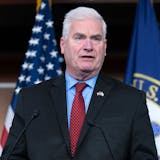It’s odd but true: Northrop Mall on the University of Minnesota’s main campus is one of the metro area’s great urban spaces. And yet, we don’t think of it as a public amenity.
But anyone can walk among the columned buildings through the great green expanse of the mall. It’s a welcoming space that feels settled and serene, a high-minded monument to Western Civ 101.
When you learn what it could’ve been, however, you might feel a bit cheated.
In 1907, the university called for plans to expand the campus. Cass Gilbert (already celebrated for the Minnesota State Capitol) submitted several designs. The U leaders chose an ambitious plan to build more than 30 structures. It would be capped on the north end by “Academic Hall,” where Northrop (formerly Northrop Memorial Auditorium) is now. A grassy mall would extend to the south, flanked on each side by classically inspired buildings.
It would have cost a fortune. A recent evaluation by the Society of Architectural Historians criticized the design for being “long on romance and short on details.”
The plan languished for a while. Eventually, Clarence Johnston, a St. Paul architect who had lost the State Capital job to Gilbert, was hired to tweak the plan and bring it in for less money. Construction began in the teens. By 1929 Northrop was finished, capping the mall.
Northop Mall echoes the Romans and the Greeks, filtered through Thomas Jefferson’s design for Monticello. The United States had a classical revival in the early years of the republic (see also, the U.S. Capitol), but that had been supplanted by other styles as the 19th century elapsed.
After the 1890s, though, the classical styles were back, thanks to the visions of a radiant city seen by millions at the World’s Columbia Exposition in Chicago 1893. The “City Beautiful” movement inspired cities across the country to draw up plans for urban renewal that echoed the broad boulevards of Paris, and blocks of uniform, compact, low-slung structures. It was modern and popular.



